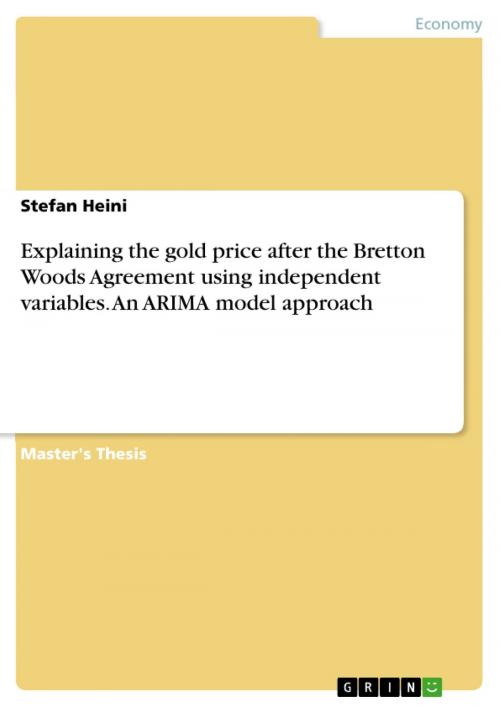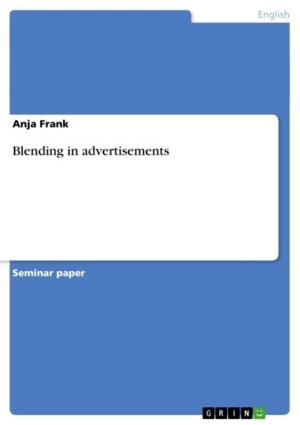Explaining the gold price after the Bretton Woods Agreement using independent variables. An ARIMA model approach
Business & Finance, Finance & Investing, Finance| Author: | Stefan Heini | ISBN: | 9783668030930 |
| Publisher: | GRIN Publishing | Publication: | August 14, 2015 |
| Imprint: | GRIN Publishing | Language: | English |
| Author: | Stefan Heini |
| ISBN: | 9783668030930 |
| Publisher: | GRIN Publishing |
| Publication: | August 14, 2015 |
| Imprint: | GRIN Publishing |
| Language: | English |
Master's Thesis from the year 2014 in the subject Economics - Finance, grade: 1.7, University of Leicester (Center of Management), language: English, abstract: To date, nobody has formulated a comprehensive theorem to determine gold valuation or precious metal prices. Until fairly recently, Eugene Fama's Efficient Market Hypothesis was the predominant paradigm explaining asset markets but today it is widely acknowledged that markets can be irrational and investors are prone to act irrationally. When trying to explain gold market anomalies, behavioural science approaches can be useful. Phenomena such as herding ('group think'), 'safe value bias' and investors' 'excessive extrapolation' can help explain positive price performance over a certain time. In this dissertation, the author investigates the applicability of a multivariate ARIMA (auto-regressive, integrated, moving average) model to help explain gold price movements from 1973 to 2011. This model uses the gold price and independent variables such as inflation, real interest rates, silver prices, the US dollar money supply (M2), oil prices, the MSCI World index and the S&P 500 as these are linked to gold and/or highly correlated with the gold price. The evaluation criteria were defined as R-squared, mean absolute percentage error (MAPE) and BIC. The model was calculated over so-called 'normal times' and times of crises (one political, one financial). The researcher used SPSS' Expert Modeler to find the best-fitting ARIMA model and to identify the independent variables significantly contributing to the fit of the model. Remarkably, a multivariate ARIMA model using independent variables explained almost twice as much of the variability of the gold price as a univariate ARIMA model using only the gold price. Also, throughout the complete period and during normal times the model explained a much higher percentage of the variability of the gold price than during crises and comparably more of the independent variables contributed significantly to the fit of the model (5 vs. 2). This can be explained by investors' tendencies to buy gold to preserve their assets ('safe value'), to follow the crowd ('herding') and to extrapolate past price chart developments. The results show that in an attempt to discern the cause of gold price movements, a multivariate ARIMA model outperforms a univariate ARIMA model significantly. The results of the study furthermore indicate researchers evaluating different methods to fit a time series should consider a multivariate ARIMA model, especially if the independent variables are highly correlated with the dependent variable.
Master's Thesis from the year 2014 in the subject Economics - Finance, grade: 1.7, University of Leicester (Center of Management), language: English, abstract: To date, nobody has formulated a comprehensive theorem to determine gold valuation or precious metal prices. Until fairly recently, Eugene Fama's Efficient Market Hypothesis was the predominant paradigm explaining asset markets but today it is widely acknowledged that markets can be irrational and investors are prone to act irrationally. When trying to explain gold market anomalies, behavioural science approaches can be useful. Phenomena such as herding ('group think'), 'safe value bias' and investors' 'excessive extrapolation' can help explain positive price performance over a certain time. In this dissertation, the author investigates the applicability of a multivariate ARIMA (auto-regressive, integrated, moving average) model to help explain gold price movements from 1973 to 2011. This model uses the gold price and independent variables such as inflation, real interest rates, silver prices, the US dollar money supply (M2), oil prices, the MSCI World index and the S&P 500 as these are linked to gold and/or highly correlated with the gold price. The evaluation criteria were defined as R-squared, mean absolute percentage error (MAPE) and BIC. The model was calculated over so-called 'normal times' and times of crises (one political, one financial). The researcher used SPSS' Expert Modeler to find the best-fitting ARIMA model and to identify the independent variables significantly contributing to the fit of the model. Remarkably, a multivariate ARIMA model using independent variables explained almost twice as much of the variability of the gold price as a univariate ARIMA model using only the gold price. Also, throughout the complete period and during normal times the model explained a much higher percentage of the variability of the gold price than during crises and comparably more of the independent variables contributed significantly to the fit of the model (5 vs. 2). This can be explained by investors' tendencies to buy gold to preserve their assets ('safe value'), to follow the crowd ('herding') and to extrapolate past price chart developments. The results show that in an attempt to discern the cause of gold price movements, a multivariate ARIMA model outperforms a univariate ARIMA model significantly. The results of the study furthermore indicate researchers evaluating different methods to fit a time series should consider a multivariate ARIMA model, especially if the independent variables are highly correlated with the dependent variable.















